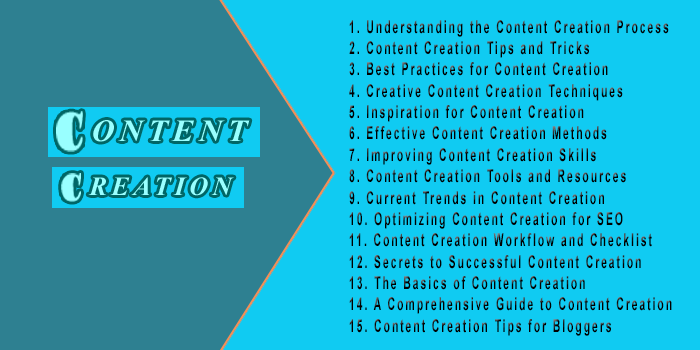Table of Contents
Understanding the Content Creation Process


Identify Your Audience: Before creating content, it’s important to understand who your target audience is. Determine their demographics, interests, pain points, and preferences. This will help you tailor your content to their needs and create a more engaging experience.
Set Goals and Objectives: Clearly define the purpose and goals of your content. Do you want to educate, entertain, or inspire your audience? Are you aiming to increase brand awareness, drive traffic, generate leads, or boost conversions? Setting clear objectives will guide your content creation efforts.
Conduct Keyword Research: Research relevant keywords related to your topic. This will help you optimize your content for search engines and improve its visibility in search results.
Plan Your Content: Develop an editorial calendar or a content plan to organize your ideas and topics. Identify the types of content you want to create (e.g., blog posts, videos, podcasts) and plan the frequency and timing of your content releases.
Outline and Research: Create a detailed outline or storyline for your content. Conduct thorough research to gather information and supporting data. Ensure your content is accurate, reliable, and backed by credible sources.
Content Creation Tips and Tricks
Know Your Audience: Understand who your target audience is, their interests, and what they want to learn or achieve. This knowledge will help you create content that resonates with them and meets their needs.
Do Keyword Research: Find relevant keywords that align with your blog’s niche and incorporate them naturally into your content. This will help your blog rank higher in search engine results and attract organic traffic.
Plan Your Content Strategy: Create an editorial calendar to plan out your content in advance. Identify important dates, events, or topics relevant to your audience, and schedule your content accordingly. This ensures a consistent publishing schedule and helps you stay organized.
Write Compelling Headlines: Craft attention-grabbing headlines that intrigue readers and make them want to click and read more. Use power words, numbers, and emotional triggers to grab attention and encourage engagement.
Structure Your Content: Organize your content in a clear and coherent manner. Use subheadings, bullet points, or numbered lists to break up your text and make it easier to read. Ensure your content flows logically from one point to another.
Best Practices for Content Creation
Understand Your Audience: Take the time to research and understand your target audience. Identify their interests, needs, and pain points. This understanding will guide your content creation and ensure it resonates with your audience.
Establish Clear Goals: Define the goals you want to achieve with your content. Whether it’s increasing brand awareness, driving traffic, generating leads, or educating your audience, having clear goals will help you create more purposeful and focused content.
Conduct Thorough Research: Always conduct proper research before creating content. Gather accurate information, data, and supporting evidence to make your content credible and valuable to your readers.
Develop a Content Plan: Plan your content in advance using an editorial calendar. Outline the topics, formats, and timelines for your content releases. A plan ensures consistency and helps you stay organized and on schedule.
Focus on Quality: Strive to create high-quality content that provides value to your audience. Offer unique insights, actionable advice, or entertaining stories. Invest time in writing well, editing thoroughly, and presenting your content professionally.
Creative Content Creation Techniques


Use storytelling: Tell stories that captivate your audience and make your content relatable. Incorporate personal experiences, anecdotes, or case studies to bring your message to life.
Incorporate visuals: Utilize compelling images, graphics, videos, or infographics to enhance your content visually. Visual elements can catch attention, break up text, and make information more digestible.
Add humor: Inject humor into your content when appropriate. Clever jokes, witty remarks, or amusing anecdotes can entertain your readers and make your content more enjoyable to consume.
Create interactive content: Engage your audience by including interactive elements such as quizzes, polls, or surveys. This allows readers to actively participate and provides a unique and engaging experience.
Tell it with infographics: Present complex data or information in a visually appealing and easy-to-understand format using infographics. Visual representations can make your content more shareable and memorable.
Inspiration for Content Creation
Stay Connected with Your Audience: Engage with your audience by monitoring comments, emails, and social media messages. Pay attention to the questions they ask, the topics they are interested in, the challenges they face. This can lead to valuable insights that can inspire new content ideas.
Explore Industry News and Trends: Stay up to date with the latest news, trends, and developments in your industry. Follow relevant blogs, news websites, and social media accounts to discover new ideas and perspectives. Consider how you can apply these trends or news to your content.
Conduct Keyword Research: Use keyword research tools to identify popular search terms related to your niche. Look for long-tail keywords, questions, or emerging topics that have high search volumes but low competition. This can help you find untapped content ideas that are in demand.
Brainstorming Sessions: Set aside dedicated time for brainstorming content ideas. Grab a pen and paper or use a digital note-taking app, and jot down any topic that comes to mind, no matter how small or seemingly insignificant. Let your creativity flow without judgment or limitation.
Explore User-generated Content: Look for user-generated content such as comments, reviews, or testimonials related to your industry. These can spark ideas for content that directly addresses your audience’s needs or common concerns.
Effective Content Creation Methods
Research: Start by conducting thorough research on the topic you plan to cover. Explore reputable sources, gather relevant data, and familiarize yourself with different perspectives. This research will help you create accurate, authoritative, and valuable content.
Identify your target audience: Understand who your audience is and what they are looking for. Conduct audience research to determine their demographics, interests, and pain points. This information will guide your content creation and ensure it is tailored to their needs.
Plan your content: Create an editorial calendar or content plan to organize your ideas, topics, and publication schedule. This ensures a consistent flow of content and helps you stay organized and focused on your goals.
Develop compelling headlines: Craft attention-grabbing headlines that entice readers to click and read further. Use strong language, numbers, or ask intriguing questions to pique curiosity and generate interest.
Utilize storytelling techniques: Incorporate storytelling elements to make your content more engaging. Share personal anecdotes, narratives, or real-life examples to connect with your audience on an emotional level and make your content relatable.
Improving Content Creation Skills
Study Successful Content: Examine content that has performed well in your niche or industry. Analyze what makes it effective, engaging, and valuable. Take note of the writing style, structure, tone, and visual elements that contribute to its success.
Read Widely: Read various genres, styles, and formats of content to expose yourself to different writing techniques, storytelling approaches, and perspectives. This can broaden your understanding of effective content creation and inspire new ideas.
Sharpen Writing Skills: Regularly work on improving your writing skills through practice and learning. Read books on writing, take online courses, or seek feedback from experienced writers. Focus on grammar, clarity, conciseness, and developing your unique voice.
Expand Your Vocabulary: Enhance your vocabulary by regularly learning new words and phrases. This can help you express ideas more precisely and eloquently. Use a dictionary or vocabulary-building resources to build your word bank.
Embrace Editing: Editing is an essential part of the content creation process. Take the time to review and revise your work to improve clarity, flow, grammar, and overall quality. Consider using editing tools or seeking feedback from others for an objective perspective.
Content Creation Tools and Resources
Grammarly: A comprehensive writing assistant that checks grammar, spelling, punctuation, and style. It helps improve the overall quality of your content by providing suggestions and corrections.
Canva: An intuitive graphic design tool that allows you to create visually appealing images, infographics, social media posts, and more. It offers a wide range of templates, fonts, colors, and elements to make your content visually engaging.
CoSchedule Headline Analyzer: A tool that analyzes your headlines for effectiveness, helping you optimize them for engagement and click-through rates. It provides insights on factors like word balance, headline length, sentiment, and keywords.
BuzzSumo: A content research tool that helps identify top-performing content in your industry. It provides insights into popular topics, trending articles, and influencers. It can help you brainstorm content ideas and create highly shareable content.
Hemingway Editor: A helpful tool that highlights complex sentences, passive voice, and unnecessary adverbs, suggesting ways to improve readability and clarity. It ensures your content is easy to understand and impactful.
Current Trends in Content Creation
Video Content: Video has become increasingly popular as a content format, with platforms like YouTube, TikTok, and Instagram Reels gaining massive audiences. Creating engaging and shareable video content can help you connect with your audience in a more interactive and visually appealing way.
User-Generated Content: User-generated content (UGC) involves getting your audience involved in creating content for your brand. This can include testimonials, reviews, social media challenges, or guest blog posts. UGC not only helps build community and trust but also provides authentic and relatable content.
Influencer Marketing: Collaborating with influencers in your niche has become a powerful way to reach a wider audience and build credibility. Influencers can create sponsored content or promote your products or services to their followers, amplifying your brand’s reach and visibility.
Interactive Content: Interactive content engages users and encourages them to actively participate rather than passively consume. This includes quizzes, polls, surveys, contests, calculators, and interactive infographics. Interactive content creates a more immersive and memorable user experience.
Live Streaming: Live streaming has gained popularity across various platforms, allowing brands and individuals to interact with their audience in real-time. Whether it’s hosting live Q&A sessions, product demonstrations, or behind-the-scenes glimpses, live streaming fosters authenticity and builds engagement.
Optimizing Content Creation for SEO
Conduct keyword research: Identify relevant keywords and phrases that your target audience uses when searching for information related to your content. Use keyword research tools like Google Keyword Planner, SEMrush, or Moz Keyword Explorer to find high-volume, low-competition keywords.
Incorporate keywords strategically: Once you’ve identified your target keywords, incorporate them naturally throughout your content. Place them in the title, headings, meta tags, URL, and within the body of the content. However, be careful not to overuse keywords, as this can be seen as spammy by search engines.
Write compelling meta tags: Craft engaging meta titles and descriptions that include your target keyword. These elements appear in search engine results pages (SERPs) and should entice users to click on your content. Keep meta titles under 60 characters and meta descriptions under 160 characters.
Create high-quality, valuable content: Search engines prioritize content that provides value to users. Focus on creating informative, well-researched, and engaging content that solves problems or answers questions. Long-form content tends to perform better in search rankings.
Structure your content with headings: Utilize heading tags (H1, H2, H3, etc.) to structure your content and indicate the hierarchy of your information. This helps search engines better understand your content and improves user experience.
Content Creation Workflow and Checklist
Establish Your Goals and Objectives: Determine the purpose of the content (e.g., inform, educate, entertain).
Define your target audience and their needs.
Set specific goals and objectives that align with your overall content strategy.
Research and Ideation: Conduct keyword research to identify relevant topics and search trends.
Use tools like BuzzSumo or Google Trends to find popular or trending topics.
Brainstorm ideas and create an editorial calendar or content plan.
Outline and Structure: Create a clear and logical outline for your content.
Divide the content into sections or subtopics.
Identify key points, arguments, or steps to include.
Gather Supporting Materials: Collect relevant research articles, statistics, or case studies.
Find credible sources and ensure all information is accurate and up-to-date.
Collect images, videos, or any other visual assets needed.
Write the First Draft: Start writing the content based on your outline and supporting materials.
Focus on getting your thoughts down without worrying too much about perfection.
Write in a clear, concise, and engaging manner. Use headings, bullet points, or other formatting techniques for better readability.
Secrets to Successful Content Creation
Define your goals and target audience: Before creating content, clearly define your objectives and identify who you’re trying to reach. Understanding your target audience’s needs, interests, and preferences will inform your content creation strategy.
Conduct thorough research: Research popular topics in your industry, stay updated on trends, and analyze competitors’ content. This will help you identify content gaps, find unique angles, and ensure your content is timely and relevant.
Create high-quality, valuable content: Aim to provide value to your audience with well-researched, informative, and engaging content. Offer unique insights, actionable advice, or entertaining content that solves problems and meets the needs of your target audience.
Develop a content calendar: Plan out your content in advance using a content calendar. This will help you stay organized, maintain consistency, and stick to a schedule. Consider incorporating a mix of different content types, such as blog posts, videos, infographics, or podcasts.
Tailor content to different platforms: Adapt your content to suit different platforms and formats. For example, optimize your blog posts for SEO, create visually appealing images for social media, or produce engaging videos for YouTube. Tailoring content to each platform will maximize its impact and reach.
The Basics of Content Creation
Define your audience: Before creating any content, it’s essential to understand who your target audience is. Research their demographics, interests, pain points, and preferences to tailor your content to their needs.
Set goals and objectives: Clearly define what you want to achieve with your content. Are you trying to educate, entertain, inspire, or sell? Establish specific goals like increasing website traffic, generating leads, or building brand awareness.
Develop a content strategy: A well-thought-out content strategy guides your content creation efforts and ensures consistency. Plan what types of content you’ll create, where you’ll publish it, and how frequently you’ll produce new content.
Conduct thorough research: Gather information, data, and insights related to your topic. Read industry blogs, research reports, and books; attend relevant conferences; and stay updated on the latest trends. This research will help you create high-quality and accurate content.
Determine content formats: Choose the most suitable content format for your message and target audience. It could be written articles, videos, infographics, podcasts, social media posts, or a combination of different formats.
A Comprehensive Guide to Content Creation
Define your objectives: Start by clarifying your goals for content creation. Are you aiming to increase brand awareness, drive website traffic, generate leads, or establish thought leadership? Understanding your objectives will guide your content strategy.
Identify your target audience: Determine who your content is intended for. Conduct market research to identify their demographics, interests, pain points, and preferences. This knowledge will help you create content that resonates with your audience.
Research and brainstorm ideas: Stay informed about industry trends and topics using tools like Google Trends, social media listening, and industry publications. Brainstorm content ideas that align with your objectives and audience needs, focusing on providing value and addressing their challenges.
Develop a content plan: Use an editorial calendar or content planner to schedule your content production and publication. This ensures consistency and organization in your content creation efforts. Map out topics, formats, and distribution channels for each piece of content.
Conduct keyword research: Identify relevant keywords related to your content topics using keyword research tools like Google Keyword Planner, SEMrush, or Moz Keyword Explorer. Incorporate these keywords naturally throughout your content to improve search engine visibility.
Content Creation Tips for Bloggers
Define your niche: Determine what specific topics or themes you will focus on in your blog. Having a niche helps you target a specific audience and become an expert in that area.
Understand your target audience: Research your target audience’s interests, needs, and pain points. Tailor your content to provide solutions, entertainment, or valuable insights that resonate with them.
Conduct keyword research: Use keyword research tools to identify popular and relevant topics within your niche. Incorporate those keywords naturally into your blog posts to improve SEO and increase your chances of ranking higher in search engine results.
Develop an editorial calendar: Plan your blog content in advance using an editorial calendar. This will help you stay organized, maintain consistency, and ensure a steady flow of fresh content for your readers.
Write compelling headlines: Craft attention-grabbing headlines that entice readers to click and read your blog posts. Use powerful words, include numbers or questions, and make sure your headline accurately reflects the value and benefits of your content.


